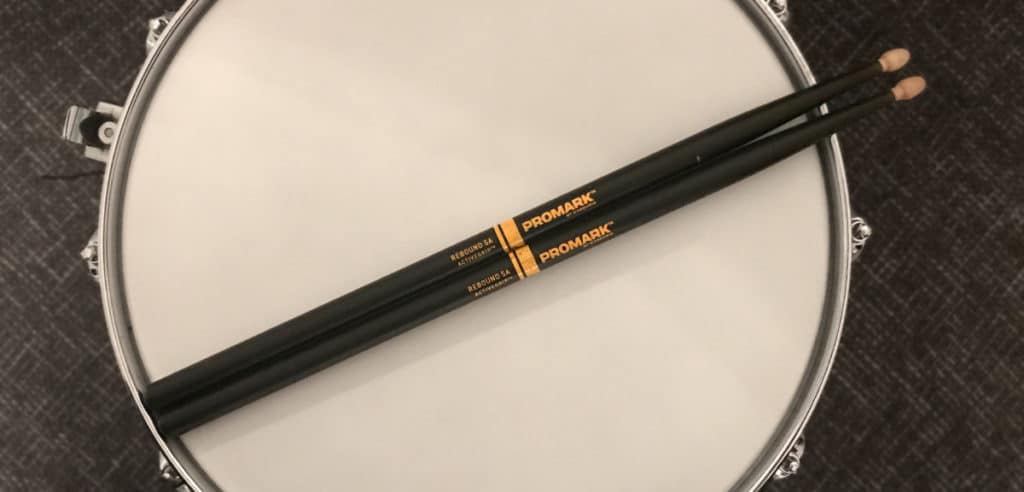
Drumsticks are probably the most requested items for drummers at the music store. As choosing the right stick contains a lot of factors, it can feel overwhelming since there is just sooo much choice! But I will help you out.
The Promark Rebound 5A ActiveGrip (Amazon link) is a very all-round drumstick that can be used in a variety of genres. This is for those who don’t have one specific genre they play to and want to have the same drumsticks to keep a consistent sound a feel to their hands. With the heat-activated ActiveGrip material, the stick offers more grip when your hands get sweaty. I love the material as it feels more comfortable and looks sick. When getting one or two pairs of these, you cannot do anything wrong.
So, most of us, when trying to select a drumstick for the first time, we usually walk into a music shop and see tons of different options. It’s kind of this random thing where you just pick the sticks and hope that you find one that feels good. But you can never really know just from those few test bounces off the practice pad. Once you played it with a band, you might find that this stick is really not the right match. So I think the best way to approach it is you need to have a little bit of background information before you go in and try.
Why I Recommend the Promark R5AAG
The Promark Rebound 5A ActiveGrip (R5AAG) is a hickory drumstick with an acorn tip. What’s so special about them, is Promark’s ActiceGrip solution. It is heat-activated, engineered to get tackier as your hands sweat, and body temperature rises.
I would say this is a very all-round drumstick that can be used in a variety of genres. Especially when you are either just starting out as a drummer, and you don’t know what exactly you will be playing right now, or you might be switching genres but want to have the same drumsticks in order to keep a consistent sound a feel to your fingers.
Of course, if you are very considerate about your choice of genre and like a really suitable stick just for that, feel free to get the best stick to match that genre.
As I have listed out below, the 5A is kind of the very all-round type; not too small and not too big. Their durability is just the same as with other average sticks. The length is 16 inches and a 0.565-inch diameter – the absolute middle thing! Now, the taper is with more weight in the front (that why it’s called “Rebound”), making you have more control and rebound, that’s nice.
Now, what I love about these sticks is the ActiveGrip material. They have this matte black finish, which I’m a real fan of. And because the grip is heat-activated, they almost feel like wood drum sticks, but as soon as your hands sweat and get a little wetter, you can profit from the grip material as it gives you extra comfort.
Check out their current price on Amazon here!
What to Look for in a Drumstick
So let me give you some pointers on how sticks can be compared and classified.
- stick length
- stick diameter
- the tip
- taper
- type of wood
- the finish
1. Stick Length
If I had to pick one stick as a baseline stick that everything else can be based around, it would probably be a 5A. Of course, every company has its own version of a 5A; however, I would call this a general-purpose drumstick.
Now, a 5A is usually around 16 inches long. When I’m trying to pick how long I want to stick to be, I have to think about the way that my kit is set up. If you are a jazz drummer and have a smaller kit with your drums and cymbals close together, I’d recommend using sticks that are a little bit shorter or around 16 inches. If you have a massive drumset with a lot of cymbals hanging way higher, you might need to get a stick that’s a bit longer than 16 inches. Just to being able to reach everything.
The way that you can find out if you need a longer stick: After playing a gig or practicing, you look down at your grip and notice whether your fulcrum (the balance point where you hold the stick) is all the way choked back. If you are, it probably means that you’re compensating, because you need to be able to reach the cymbals. Now, either change the way your kit is set up or switch to a longer stick!
2. Stick Diameter
The diameter is how wide the stick is. On average, most are around .565 inches. You can get bigger than that, or you can get smaller, and there are pros and cons to each.
If you go with a wider diameter, you’re going to find you have a lot more power, and you’re not going to have to work as hard to get a huge sound out of your instruments. If you go smaller, you’re going to get more speed. So you have to ask yourself: Does my playing require a lot of power or a lot of speed?
3. The Tip
The tip of the stick makes a humongous difference in the sound. The reason is, the shape of the tip affects how much of the actual wood is making contact with the drumhead or the cymbals. The finer the impact area, the more articulate the sound will be. If you have a bigger surface area touching the cymbal or drumhead, you’ll get a warmer, maybe darker and more full sound. There are all kinds of different tips shapes, which I won’t go into detail here. The main question here is: Are you looking for a big, fat sound? Or are you looking for an articulate sound?
The other thing I want to make sure that I mention is the type of material. Most of them are wood tips, just like the rest of the stick. But some people like to use nylon tips, and there’re two reasons for this. One, the tips won’t break like they might on a wood one. The second thing is that you’re getting more articulation since nylon sounds differently than wood. I personally don’t like nylon tips because I don’t like the way that they sound.
4. Taper
What is the taper? The taper is where the drumstick starts to get more narrow as you reach the tip. It affects how the stick is weighed in your hands.
Having the stick’s weight most of the way in the back, you feel to get more control and rebound. Having it instead in the front, you’ll have a lot more power.
5. Type of Wood
There are a lot of different kinds of wood out there. Probably there’re three main types of wood used for making drumsticks. The lightest wood is maple, sort of the middleweight would be hickory, and the heaviest would be oak.
When using an oak stick, it’s going to last longer because the wood is thicker. The downside of having a more massive stick is that you might lose a little speed, and you might not like the way it feels.
If you use a maple stick, since it is a lighter stick, you will lose a bit of durability. You might break your sticks more often, but that might be a sound that you’re looking for, and you might like the feeling of a lighter stick in your hand.
Oh, wait. There’s not only wood around! Other materials include graphite, which is exceptionally durable but a bit pricier than wood. The latest development in drumstick technology would be aluminum sticks. They have benefits like higher speed, better balance, extreme durability, and a reduced vibration that is transferred to your hands while playing.
6. The Finish
A lot of us forget about such things like the actual way how the stick is finished. There’re three different types:
Natural finish. Nothing is put on the stick. Some people like the way that it feels in their hands. When your hands are rather sweaty, the sticks will absorb the sweat, making you feel like you have an excellent grip.
Lacquer finish. The reason why lacquer is put on there is that it resists the moisture, which is kind of a nice thing since that’s making the sticks last a bit longer. But the problem is with sweaty hands; the sticks are slipping out of your hands more likely. Some people may not like that, and some may love it.
Grip material. This is starting to come out more frequently now. Some companies place a grip material on the drumstick, allowing you to grip the stick a bit easier. This might be for people that have sweaty hands with their sticks slipping out of their hands all the time. Personally, I like the grip material as it feels more comfortable and looks cool (like the Promark sticks I recommend).
